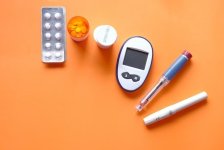Diabetes: Symptoms, Causes, & Diabetes Treatment
Diabetes: This is a long-term disease that occurs when the body's cell is incapable of utilizing the blood sugar (glucose), which loadcells to damage due to the cells' inability to acquire energy. In a normal body function, the body cells take up glucose from the blood and use it for energy, repairs, and of course, for the proper functioning of the overall body system.
Diabetes occurs due to the inability of the body cells to use energy in the sugar for their normal daily activities. These sugars not used by the body are stored in the bloodstream; this will result in a severe increase in the sugar content of the blood, which prevents the body from working correctly and sometimes result in death when it is not treated correctly.
The pancreas produces insulin. These insulin products are transferred from the pancreas to the blood. The insulin act like an agent informing the body cells to open and absorb sugars for their normal functions, and when this is not done correctly, it results in diabetes.
Causes of Diabetes
Diabetes occurs when the pancreas isn't producing the required quantity of insulin and also when insulin is produced in the pancreas. Still, the body cells are not capable of utilizing and making use of it properly. Which are generally classified into two types which include
TYPE 1 DIABETES: This is an automatic process in which the body's defense mechanism attacks cells that function in insulin production, causing dead insulin-producing cells, which results in no insulin production. This type of diabetes is usually found in teenagers and people below 40 and is rarely seen in the elderly.
Usually people with type 1 diabetes, insulin is administered directly into the bloodstream to reduce blood sugar and aid in the proper absorption and utilization of glucose by the body cells.
TYPE 2 DIABETES: Type 2 diabetes occurs when the body secretes or manufactures less insulin, incapable of leading to the normal function of the body cells. This is mainly found in people over 40 and mostly in the elderly.
It is also important to note that 85% of people with diabetes are usually diagnosed with type 2 since this is mainly found in older and middle-aged people.
PRE-DIABETES: This is a progressive stage of the body into a diabetic condition. High blood sugar, abnormal body weakness and some minor diabetic symptoms accompany this.
Risk Factors Associated With the Development of Diabetes
a) Family history of diabetes might increase your risk of developing diabetes: Diabetes can be inherited by offspring. Research shows that 8% of diabetes cases are always linked to parents in one way or the other. Therefore, a proper check-up is essential at this stage to know your status and to keep proper monitoring for proper and effective treatment at early-stage if diagnosed.
b) Pancreatic disease and infection: These include cancer, tumors, and sometimes poison due to bacteria, viruses, and chemicals that impair the normal function of the pancreas.
c) physical stress: This includes lack of proper sleep and stress due to body overwork.
d) being overweight
e) lack of regular exercise and inactivity
f) heart-related disease or family history of heart problems
g) smoking
Symptoms of Diabetes
Both type 1 and type 2 diabetes have similar symptoms, which usually result in high blood sugar, which affects the heart, brain, liver, and other vital organs of the body. The general symptoms of diabetes include
1) Fatigue and general weakness
2) Abnormal or blored vision
3) Tingling and numbness sensation on the feet and other parts of the body
4) Frequent urination
5) Weight loss
6) wounds take an abnormally long period to heal.
When these symptoms are observed, it is wise to see a physician for proper examination and treatment to avoid complications.
COMPLICATIONS ASSOCIATED WITH DIABETES INCLUDE:
1) Cardiovascular diseases such as stroke, high blood pressure, and high cholesterol.
2) Neuropathy ( nerves damage that results in tingling and burning sensation around the fingers and toes)
3) Kidney Damage
4) Dementia
5) Hearing problems.
Conclusion:
People with diabetes can live an everyday life by changing their lifestyle to reduce the damage diabetes will cause to the body. A proper examination by the physician can determine the most suitable treatment. For example, avoiding food with high sugar content is one way to prevent high sugar levels.
Last edited by a moderator:





